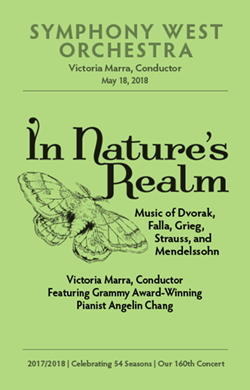
In Nature's Realm
May 18, 2018, 7:30 p.m.
Victoria Marra, Conductor
Featuring Grammy Award-Winning pianist Angelin Chang
Sponsored by The Cleveland Indians
In Nature’s Realm, Opus 91 - Antonin Dvorak (1841-1904)
Morning Mood from Peer Gynt - Edvard Grieg (1843-1907)
Fingal’s Cave (The Hebrides) - Felix Mendelssohn (1809-1847)
Symphony #82 “The Bear”
- Franz Joseph Haydn (1732-1809)
IV Finale Vivace assai
INTERMISSION
Dance of the Swans from Swan Lake - Tschaikovsky (1840-1893)
Nights in the Gardens of Spain -
Manuel de Falla (1876-1946)
I En el Generalife In the Architect’s Garden
II Danza lejana A Distant Dance
III In the Gardens of the Sierra de Cordoba
Angelin Chang, Piano
Clear Track, Polka schnell, Opus 45 - Johann Strauss, Jr. (1825-1899)
Program Notes
Nights in the Gardens of Spain (Noches en los jardines de España)
Along with Isaac Albéniz and Enrique Granados, Manuel de Falla (1876–1946) was one of Spain’s most important musicians of the first half of the 20th century. His image was printed on Spain’s 1970 100-pesetas banknote.
Manuel de Falla was from Andalusia and his work refers to both the Spanish and Arabic past of this region (Al-Andalus).
Falla began this composition as a set of nocturnes for solo piano in 1909. On the suggestion of pianist Ricardo Viñes he turned the nocturnes into a piece for piano and orchestra. Falla completed it in 1915 and dedicated it to Viñes; however, the pianist at the first performance was neither Viñes nor Falla but José Cubiles. The premiere was April 9, 1916 at Madrid’s Teatro Real with the Orquesta Sinfónica de Madrid conducted by Enrique Fernández Arbós.
Viñes played the work in its San Sebastián premiere with the same orchestra. Arthur Rubinstein was in the audience and subsequently introduced the work to Buenos Aires, Argentina. The Paris premiere took place in January 1920 with pianist Joaquín Nin. Manuel de Falla was the soloist at the London premiere in 1921.
Falla’s composition depicts three gardens:
En el Generalife (In the Architect’s Garden), the jasmine-scented gardens surrounding the Alhambra.
Danza lejana (A Distant Dance), a distant garden in which there is an exotic dance. This music strives to suggest the movements of the mystic Sufi dancers.
En los jardines de la Sierra de Córdoba (In the Gardens of the Sierra de Córdoba) The best-known inhabitant of the gardens of the Sierra de Córdoba was the Sufi philosopher Ibn Masarra and the dances depicted here are, presumably, Sufi dances.
Falla referred to Nights in the Gardens of Spain as “symphonic impressions.” The piano part is elaborate, brilliant, and eloquent. It is integrated with the orchestration and is only occasionally dominant. The orchestral texture is lush and evocative. This is Falla’s most impressionistic score, in which is expressed “an intimate and passionate drama.”





